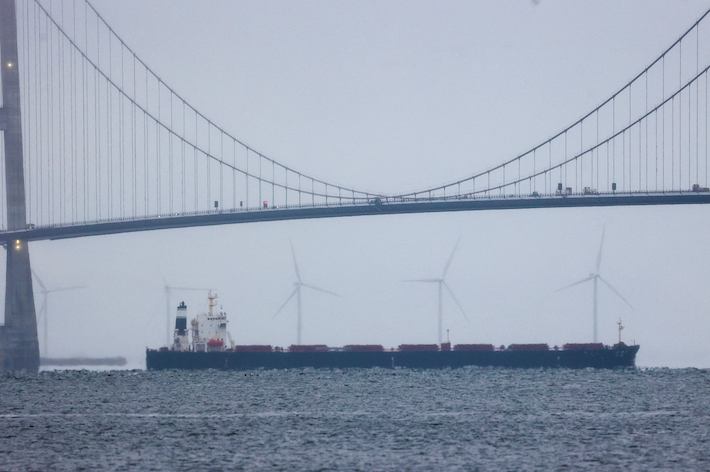European investigators suspect the crew of a Chinese bulk carrier deliberately dragged its anchor for more than 100 miles to cut two underwater cables in the Baltic Sea earlier this month, according to new reports.
NATO warships from Denmark, Germany and Sweden have surrounded the Yi Peng 3, a 225-metre-long vessel, for over a week in international waters between Sweden and Denmark to investigate the ship’s role in the incidents.
But, Western law enforcement and intelligence officials have told the Wall Street Journal they don’t believe the Chinese government was involved. Rather, the probe is allegedly focused on whether Russian officials got the vessel’s captain to undertake an act of sabotage after it departed from the Russian port of Ust-Luga, according to reports by WSJ and Engadget.
ALSO SEE: Australian Law Bans Social Media for Children Under 16
The ship’s owner, Ningbo Yipeng Shipping, is said to be cooperating with the investigation and has allowed the vessel to remain in international waters, but the company has so far declined to comment.
Officials in Sweden urged the skipper of the Chinese cargo ship to return to Swedish waters on Tuesday to facilitate the investigation that began after the cutting of two underwater cables on November 17 and 18, local media reports said.
The Wall Street Journal has said the first cable between Sweden and Lithuania was cut at 10am on November 17, and the second one between Finland and Germany at 3am the next day, before the ship started zigzagging, raised anchor and left.
Investigators allegedly found the ship’s anchor and hull had damage consistent with have dragged its anchor and severed cables. Analysts have said the likelihood of the incident being an accident was small because the weather was mild and there were only small waves.
The captain of the vessel is a Chinese national, but has a Russian crew member, it said. They do not appear to have been interviewed yet.
The Kremlin has described the claim of sabotage as “absurd” and “unsubstantiated”, while noting that Western officials “were silent when Ukraine blew up the NordStream gas pipelines,” the WSJ said.
And Chinese officials in Beijing have said it requires all vessels to strictly comply with international law.
‘Clarity’ sought on cable incidents
Meanwhile, Swedish prime minister Ulf Kristersson said on Thursday (Nov 28) that Swedish authorities were seeking “clarity” from China on what happened to the two fibre-optic cables last week.
“Today I can tell you that we have additionally sent a formal request to work together with Swedish authorities to get clarity about what has happened,” he said in a press conference. “We expect China will choose to work together as we have requested.”
Kristersson emphasised that he is “not making any accusations” but wants to “seek clarity on what has happened.”
Euronews reported that Anders Lomholt, a defence correspondent with Denmark’s TV 2, alleged that the Chinese ship slowed down when it sailed over other cables and completely stopped when it reached the last cable.
In an interview with Jens Wenzel Kristoffersen from Nordic Defence Analysis, Lomholt said it is “not normal behaviour for a merchant ship” to lie still on top of cables, the report said.
Swedish authorities have declined to comment on the Danish or WSJ reports, but some have said the anchor theory was feasible as there was no seismic signals to indicate explosions, like when the NordStream pipelines were sabotaged in September 2022.
In a separate incident in October 2023, the BalticConnector gas pipeline was also badly damaged. Finnish investigators recovered a large ship’s anchor near the spot, which was linked to a Chinese container vessel, NewNew Polar Bear. Russian sailors were on board that vessel at the time of the incident, the WSJ said.
China admitted responsibility for that incident in August, but claimed it was an accident caused by a strong storm, according to a report by the South China Morning Post.
A US scholar at the University of Pennsylvania the Yi Peng 3 only operated in Chinese waters from late 2019 till March this year, when it suddenly started carrying Russian coal and other cargo from Russian ports, the WSJ said. It is currently carrying Russian fertilizer, according to Kpler.
A Guardian report on Thursday quoted the Swedish prosecutor as saying: “The cable between Sweden and Lithuania, which is owned by a Swedish company, was damaged on 17 November. The cable between Finland and Germany, located south of the Sweden-Lithuania cable, was damaged a number of hours later. Both damage sites are located within the Swedish economic zone.”
Nordic and Baltic leaders now class the Baltic Sea as a “high-risk zone” but have been careful not to describe the latest incidents as ‘sabotage’ until they have absolute proof to verify that.
The good news is the first cable, between Sweden and Lithuania, has been repaired, the operator Arelion has said.
- Jim Pollard
























